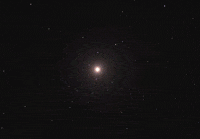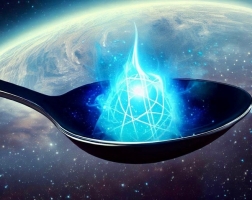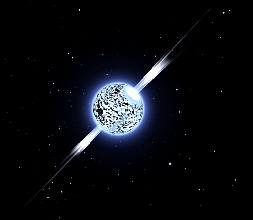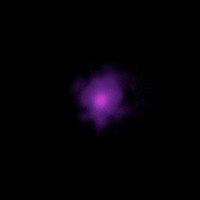  Neutron stars are formed when a massive star runs out of fuel and collapses. The central region of the star, the core, collapses, crushing together every proton and electron into a neutron.
Neutron stars are formed when a massive star runs out of fuel and collapses. The central region of the star, the core, collapses, crushing together every proton and electron into a neutron. This collapse happens because the radiation pressure outward provided by the nuclear fusion of atoms starts to decrease as the fuel runs out. As this outward pressure gets smaller, it can no longer support the huge mass of the gases of the star, which begin to fall toward the centre because of gravity.  If the core of the collapsing star is between about 1 and 3 times the mass of our Sun, these newly-created neutrons at the core can stop the collapse, leaving behind a neutron star. Stars with higher masses explode as supernovas, some leaving behing neutron stars, but if the star was massive enough, the star will continue to collapse, eventually becoming a black hole. If the core of the collapsing star is between about 1 and 3 times the mass of our Sun, these newly-created neutrons at the core can stop the collapse, leaving behind a neutron star. Stars with higher masses explode as supernovas, some leaving behing neutron stars, but if the star was massive enough, the star will continue to collapse, eventually becoming a black hole.  A neutron star is the densest object astronomers can observe directly. The former star, with the mass of half a million Earths, has collapsed into a sphere about 20 kilometres across. A neutron star is the densest object astronomers can observe directly. The former star, with the mass of half a million Earths, has collapsed into a sphere about 20 kilometres across. One teaspoon full of neutron star material would weigh about 1 trillion kilograms on Earth ... about as much as a mountain.  Many neutron stars are undetectable because they simply do not emit enough radiation. However, under certain conditions they can be observed. Some neutron stars have been found at the centres of supernova remnants, emitting X-rays.
Many neutron stars are undetectable because they simply do not emit enough radiation. However, under certain conditions they can be observed. Some neutron stars have been found at the centres of supernova remnants, emitting X-rays. For example, at the center of the Crab nebula (left) is a supernova remnant. The supernova explosion in 1054 AD was observed by Chinese astronomers. The remnant is a neutron star spinning at 30 times per second, emitting pulses of radiation from gamma rays to radio waves. Neutron stars are often found spinning, with extreme magnetic fields. They're called pulsars or magnetars. In binary systems, some neutron stars can be found gravitationally 'sucking in' materials from their companions, and emitting electromagnetic radiation powered by the gravitational energy of the falling material. Pulsars  Most neutron stars are observed as pulsars. Pulsars are rotating neutron stars from which we can detect pulses of radiation at very regular intervals, ranging from milliseconds to seconds. Pulsars have very strong magnetic fields which funnel jets of particles out along their two magnetic poles. Most neutron stars are observed as pulsars. Pulsars are rotating neutron stars from which we can detect pulses of radiation at very regular intervals, ranging from milliseconds to seconds. Pulsars have very strong magnetic fields which funnel jets of particles out along their two magnetic poles.
 These accelerated particles produce very powerful beams of light. Often the magnetic field isn't aligned with the spin axis, so those beams of particles and light are swept around as the star rotates. When the beam crosses our line-of-sight, we see a pulse; we see pulsars turn on and off as the beam sweeps over Earth. A pulsar is much like a lighthouse; even though its light is constantly shining, we only see the beam when it is pointing directly in our direction. These accelerated particles produce very powerful beams of light. Often the magnetic field isn't aligned with the spin axis, so those beams of particles and light are swept around as the star rotates. When the beam crosses our line-of-sight, we see a pulse; we see pulsars turn on and off as the beam sweeps over Earth. A pulsar is much like a lighthouse; even though its light is constantly shining, we only see the beam when it is pointing directly in our direction.
Magnetars  Another type of neutron star is called a magnetar. In a typical neutron star, the magnetic field is trillions of times as strong as Earth's however, in a magnetar, the magnetic field is another 1000 times stronger than that. Another type of neutron star is called a magnetar. In a typical neutron star, the magnetic field is trillions of times as strong as Earth's however, in a magnetar, the magnetic field is another 1000 times stronger than that.In a magnetar, with its huge magnetic field, movements in its crust cause the neutron star to release a vast amount of energy in the form of electromagnetic radiation. A magnetar called SGR 1806-20, for example, had a burst where in one-tenth of a second it released more radiation energy than the Sun has emitted in the last 100,000 years! Neutron stars are also involved in the creation of kilonova explosions. |